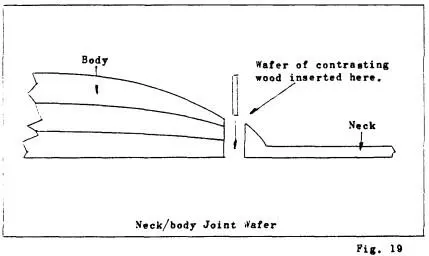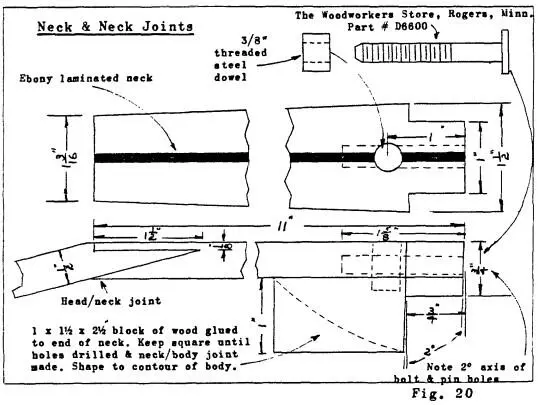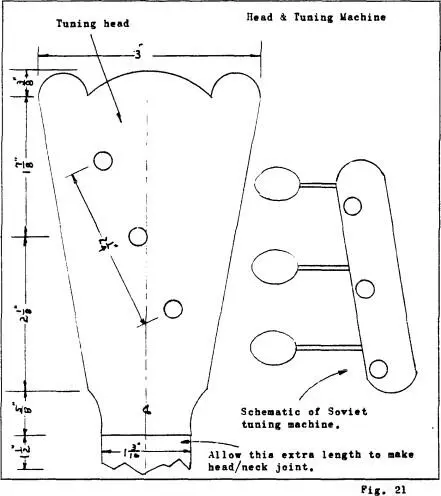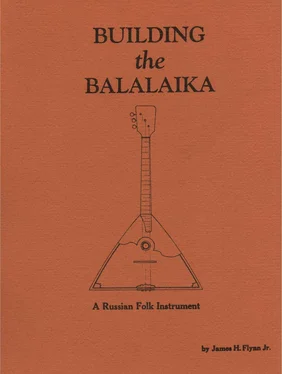James Flinn - Building the Balalaika
Здесь есть возможность читать онлайн «James Flinn - Building the Balalaika» весь текст электронной книги совершенно бесплатно (целиком полную версию без сокращений). В некоторых случаях можно слушать аудио, скачать через торрент в формате fb2 и присутствует краткое содержание. Год выпуска: 1984, ISBN: 1984, Жанр: Руководства, music, на английском языке. Описание произведения, (предисловие) а так же отзывы посетителей доступны на портале библиотеки ЛибКат.
- Название:Building the Balalaika
- Автор:
- Жанр:
- Год:1984
- ISBN:0-9613258-0-1
- Рейтинг книги:4 / 5. Голосов: 1
-
Избранное:Добавить в избранное
- Отзывы:
-
Ваша оценка:
- 80
- 1
- 2
- 3
- 4
- 5
Building the Balalaika: краткое содержание, описание и аннотация
Предлагаем к чтению аннотацию, описание, краткое содержание или предисловие (зависит от того, что написал сам автор книги «Building the Balalaika»). Если вы не нашли необходимую информацию о книге — напишите в комментариях, мы постараемся отыскать её.
Building the Balalaika — читать онлайн бесплатно полную книгу (весь текст) целиком
Ниже представлен текст книги, разбитый по страницам. Система сохранения места последней прочитанной страницы, позволяет с удобством читать онлайн бесплатно книгу «Building the Balalaika», без необходимости каждый раз заново искать на чём Вы остановились. Поставьте закладку, и сможете в любой момент перейти на страницу, на которой закончили чтение.
Интервал:
Закладка:
The inside rib joints are now reinforced by gluing 1/ 2” wide linen tape over the seams. This is done by spreading glue along the joint., line, embedding the tape in the wet glue, and applying more glue over the tape while pressing the tape flat against the joint. As an aside, I have left no stone unturned in a search for linen tape. I have made inquires from Texas to Maine and many places in between with no luck. I have settled upon linen cloth which I bias-cut on a 45° angle. I suppose that cotton tape would do as well but linen seems to be preferred by many old-time luthiers, Do not use tape made from synthetic material such as nylon. I have made many experimental joints and found that it does not glue-up properly. Back to the balalaika. We now need to surface the top edges of the body before fitting the soundboard. First, we must keep in mind that the soundboard is slightly convex to the extent that its center, near the bridge, is approximately 1/ 8" above the edges of the body. In surfacing the edges of the body try to allow for this slight taper so that the soundboard will have a good fit. I have noticed that some balalaikas have a tapered edge to the transom that conforms to the curvature of the soundboard. This is illustrated in Fig. 17 and perfectly acceptable.

A neat way of leveling the top edges of the body, as well as smoothing the face of the transom, is to glue four pieces of 120 grit sandpaper to a flat surface, preferably something akin to Formica, forming a 18 x 22" surface plate. The body is then placed upon this surface and rubbed until it is flat.
The inside surfaces of the body are now ready for final cleanup. The side linings, which were l/2" square when originally installed, must now be reduced in size to a triangular shape. See Fig. 18.

The Dremel Moto-Tool with burr bits does a fast job of this. Linings along the ribs and transom are finished in the same fashion. Sand the inside surfaces of the body as if you were making a salad bowl. When finished, seal the inside surface with a thin coat of shellac.
The object is to reduce the weight of the instrument by removing all superfluous wood and to produce a gracefully curved interior which should add to the acoustical quality of the balalaika. Further, you may feel a vibration or two when a luthier works on the instrument a century later and remarks about the fine quality of this "old" instrument.
We will now trim the excess stock from the end block. Carefully saw these rib ends flush with the block. Sand this end taking every precaution to assure that the edge geometry is true. Keep in mind that the neck is to mate with this surface and we want this alignment to be accurate. A nice decorative touch to this joint is to add a 1/ 8to 1/ 4" wafer between the end block and the shoulder of the neck as illustrated in Fig. 19. If you do this make sure that you extend the length of the tenon on the neck to compensate for this additional depth.

The Head and Neck
The head and neck are made as an assembly and rough-shaped before being attached to the body. The function of the head (sometimes referred to as the "shovel" in Russian terminology) is to hold the tuning machines for the strings and that of the neck to hold the fingerboard with its frets. Again, it is important to select wood of proper strength (most important), grain orientation, figuration, and color. Common practice is to use the same species of wood used in the body. Curly maple, or other figured wood, does not make a strong neck because of its twisted grain. This can not be tolerated at the critical neck/head joint. However, there is no prohibition against using woods which complement the body such as a maple head and neck on a rosewood body. As usual, there are several choices of wood combinations best left up to the player. You will notice that the contour of the neck as it joins the head reveals a very small amount of wood stock holding the neck to the head. To insure rigidity and strength the entire neck is laminated with a thin strip of ebony approximately 1/ 8" thick. This sandwiched neck is shown in Fig. 20. The "V" joint for the head and the neck is shown in Fig, 20. These two pieces are joined and glued in the "square" and then shaped to proper form after the joint is dry. This makes clamping a lot easier. A suggested head shape is shown in Fig. 21. The head drops back 15° from the neck.


Acquiring tuning machines for the balalaika has been a problem. The outline of a Soviet tuning machine is depicted in Fig. 21. As of this date, such machines are not available outside of the Soviet Union. I have written to the Lunacharski Musical Instrument Factory in Leningrad, where most of the balalaikas are made, and was advised that "spare parts" were not available. A source of a good quality tuning machine is suggested in the Appendix. Machines available from this supplier are not top-of-the-line and may have to be taken apart and reworked. This is not a reflection on the supplier but a recognition of the fact that these are probably the only machines available in the West. The Russian machines are completely recessed into the head and then covered with a metal plate. The machine from the source mentioned above is best mounted by recessing only the plate holding the string posts. Whatever type machine used, be careful that the recess does not weaken the head/neck joint. Other machines from instruments such as guitars, mandolins, etc., may be reworked and adapted to the balalaika. In so doing, do not change the basic character of the head. Keep the string posts in line with the string as it passes over the nut and keep the tuning knobs on the right side of the head.
The conventional joint for the neck to body interface on most musical instruments is some form of a tapered dovetail dado. The dado (channel) is cut into the end block and the dovetail cut in the shoulder block of the neck. This is an excellent joint. However, I use a form of this joint which is reinforced and in my judgement offers superior strength yet rather easy to machine. The heart of the joint, which is shown in Fig. 20, is a steel pin and threaded steel dowel stocked by the Woodworkers Store, Rogers, Minnesota, under part number D6600. This joint is made by first gluing to the neck a block of wood slightly larger than the profile of the shoulder block on the body. Keep this block square at this time as it will be easier to glue and hold clamps. Follow the dimensions in making the mortise and tenon for this joint which are specified in Fig. 20. Before permanently attaching the head and neck assembly to the body check to make sure that the top surface of the neck is 1/ 8" higher than the top of the shoulder block. This height offset is necessary to allow for the addition of the soundboard which, when installed, will be flush with the edge of the neck before the fretboard is installed. Also check to insure that the body drops 2° from the top surface of the neck; that the centerline of the body is in line with the centerline of the neck; and that the neck is not twisted out of alignment with the imaginary surface of the soundboard. An effective method for checking the proper alignment of the neck and body is to temporarily assemble the neck and body and place the neck on a flat surface such as a table. Measure the distance from the corners of the body to the table top and adjust the joint until these measurements are equal.
Читать дальшеИнтервал:
Закладка:
Похожие книги на «Building the Balalaika»
Представляем Вашему вниманию похожие книги на «Building the Balalaika» списком для выбора. Мы отобрали схожую по названию и смыслу литературу в надежде предоставить читателям больше вариантов отыскать новые, интересные, ещё непрочитанные произведения.
Обсуждение, отзывы о книге «Building the Balalaika» и просто собственные мнения читателей. Оставьте ваши комментарии, напишите, что Вы думаете о произведении, его смысле или главных героях. Укажите что конкретно понравилось, а что нет, и почему Вы так считаете.












